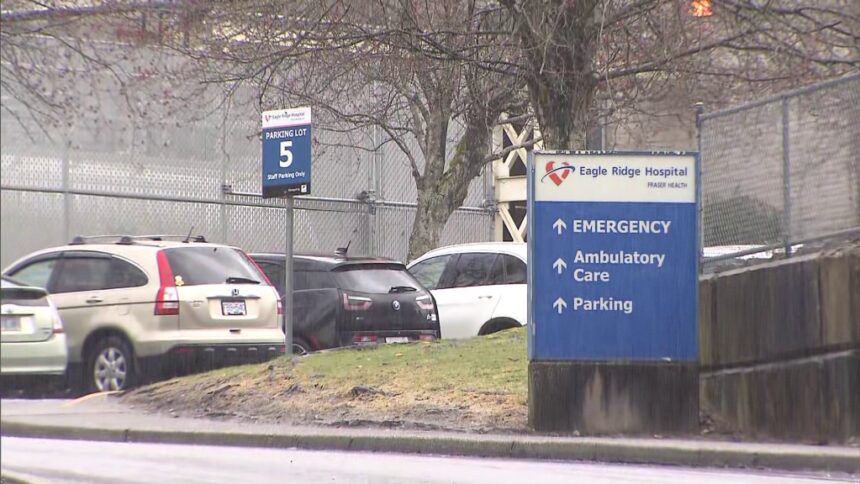I stood outside Royal Columbian Hospital last Wednesday morning, watching the steady stream of patients and staff move through sliding glass doors. The building’s imposing concrete façade betrayed nothing of the internal struggles playing out within its walls—struggles that have now spilled into public view through an unprecedented lawsuit filed by emergency physician Dr. Sean Keenan against Fraser Health Authority.
“We’ve been raising alarm bells about unsafe staffing levels for years,” said Adriane Gear, vice president of the BC Nurses’ Union, as we sat in a nearby café. Rain tapped gently against the windows while she stirred her untouched tea. “What’s different now is that physicians are starting to speak out too.”
Dr. Keenan’s lawsuit, filed in BC Supreme Court last month, alleges that Fraser Health leadership repeatedly ignored his warnings about dangerous understaffing in emergency departments across the region, creating conditions that he claims directly contributed to preventable patient deaths. The case has sent shockwaves through British Columbia’s healthcare community.
The BCNU’s decision to publicly support Dr. Keenan marks a significant moment of solidarity between nursing and physician groups—historically separate in their advocacy approaches despite sharing frontline spaces.
“When I started nursing twenty years ago, we had time to sit with patients, to really assess their needs,” Gear explained. “Now our members report spending entire shifts just trying to keep their heads above water. The emotional toll is devastating.”
According to Statistics Canada’s 2024 Healthcare Worker Survey, 68% of nurses in British Columbia reported experiencing symptoms of burnout in the past year, compared to 54% nationally. Fraser Health, which serves 1.9 million residents across 20 communities, has consistently shown higher nurse vacancy rates than other health authorities in the province.
Nurse Marilyn Chen, who has worked in Royal Columbian’s emergency department for eight years, described the situation with quiet intensity. “Last winter, I had shifts where I was responsible for monitoring 12 acute patients simultaneously. That’s not just difficult—it’s impossible to do safely.”
Chen’s experience aligns with internal documents obtained through freedom of information requests by the Hospital Employees’ Union, which revealed that Fraser Health emergency departments operated below minimum staffing guidelines on 72% of shifts between September 2023 and February 2024.
Fraser Health has filed a statement of defense characterizing Dr. Keenan’s lawsuit as “fundamentally misrepresenting the complex realities of healthcare delivery in a post-pandemic environment.” Their spokesperson declined my request for an interview but provided a written statement emphasizing the authority’s “ongoing commitment to patient safety and staff wellbeing during unprecedented challenges.”
The lawsuit comes amid growing tensions between healthcare workers and administrators across Canada. A recent report from the Canadian Institute for Health Information shows emergency department wait times in BC increased by 22% between 2019 and 2023, while the Canadian Association of Emergency Physicians has documented a concerning exodus of experienced emergency doctors from the profession.
“This isn’t just about working conditions—though those matter tremendously,” said Dr. Martha Weisman, president of the BC Medical Association, when I reached her by phone. “This is fundamentally about patient safety and the moral injury healthcare providers experience when system failures prevent them from providing the care they know patients deserve.”
Walking through Royal Columbian’s emergency waiting room later that afternoon, I counted 47 people sitting in chairs designed for 30. A digital display showed estimated wait times of over six hours for non-urgent cases. An elderly woman with a bandaged arm slept upright in her wheelchair while a young father paced with a feverish toddler.
For the BCNU’s Gear, supporting Dr. Keenan’s lawsuit represents a strategic shift. “Historically, nurses have pursued workplace concerns through collective bargaining and grievance processes. But the system is so broken that traditional approaches aren’t enough anymore.”
The union has launched its own initiative called “Code Critical,” documenting instances where nurses believe patient safety has been compromised due to staffing shortages. They’ve collected over 3,200 reports since January.
Meanwhile, Fraser Health has announced plans to accelerate recruitment efforts, including international hiring and expanded training partnerships with local colleges. Critics, including both the BCNU and Dr. Keenan, argue these measures fail to address underlying systemic issues like retention, psychological safety for whistleblowers, and meaningful staff input into operational decisions.
As the lawsuit proceeds through preliminary hearings, healthcare advocates are watching closely. Legal experts suggest the case could establish important precedents regarding administrators’ duty of care and healthcare providers’ protected speech when raising safety concerns.
For patients like Abigail Morris, who spent 11 hours in Royal Columbian’s emergency department after a car accident last month, the legal battle reflects lived reality. “The nurses and doctors were clearly trying their best, but there just weren’t enough of them,” she told me. “You could see the exhaustion in their eyes.”
As evening fell and shift change approached at the hospital, I watched nurses and doctors stream through those same sliding doors—some ending their workday, others just beginning. Whatever the lawsuit’s outcome, the daily reality of healthcare delivery continues, with thousands of patients depending on a system that those who know it best describe as fundamentally broken.
“We don’t take joy in this fight,” Gear said as we ended our conversation. “But sometimes caring for patients means fighting for the conditions that make good care possible. That’s what this is really about.”






